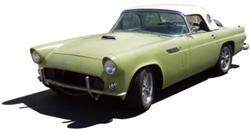I think that "answers" to the various cooling woes - that go with hot weather and "hot" engines are found by using a methodical approach. The Y powered vehicles we all seem to have collected up - they all had some sort of decent heat control capability built-in to start with. Restoring that capability can take a bit of troubleshooting - and assuring that the basics are in place. Just make a check off list and grind your way through it.....
(1) Radiator needs to be the right size and in good shape - not full of gunk and sediment. Because I live in southwest USA, I had mine reworked by an outfit that often works on desert driven vehicles. They make sure the re-conditioned units will take a healthy pressure cap of the OEM rating. If it has (or had) any shrouding - be sure you have it or are aware of the need for missing parts.
(2) Make sure there is a good, working thermostat in place. It needs a large enough opening to flow the "gallons per minute" the system was designed for. I found that my engine had a small thermostat poppet (fitted in a big blank disc) - which seems to be common practice for cheapo Chinese parts these days. Tests have shown that you lose a couple of GPM with the small poppet at low idle - and more as the rev's climb. Test the one you choose, by heating it and making sure that it opens and closes properly before you install it. A 180ºF rated unit should work well just about anywhere.
(3) A decent fan and belt needs to be in place. In the US and Canada, a six blade is a good choice and usually readily available. If it is fitted into a shroud make sure it is the right diameter and spaced correctly.
(4) The water pump must actually work. We had a fellow visit the site - who had a lot of heat problems with his 272 - and when he finally got some gaskets and removed the water pump, he found that the impeller blades had long since rusted away to nearly nothing. It pumped nothing - with a replacement pump, the system worked.
(5) The engine block has to have some useable water passages - many are found to be full of rust and other deposits - and water is just not circulating. Flushing a running system with white vinegar - or a made for the purpose acidic "cleaner" can sometimes do the trick. In the worst cases, fellows have had to remove the "freeze" plugs and auger out some of the deposits by mechanical force. The degradation of the cooling ability of our old blocks can really work against the other components we've put in place.
(6) Its OK to test and prove your system with tap water - but when real world use is what you need - use the chemical advantage of a 50/50 antifreeze mixture. The elimination of "boil over" being a numero uno goal - the additional suppression of the boiling point is what you want on a long summertime trip.
(7) Pressure Cap rating - many find that when their systems are in good condition and well balanced - they can run a lower than factory rating cap. If they aren't experiencing "boil-over" situations, it can be sensible to avoid stressing an old radiator. I run mine (reconditioned as above) with the factory cap rating - and I had it tested to be sure - because the desert here is an unrelenting heat load.
(8) Know for sure what "HOT" is. Hot is when your system is prone to boiling over - and not especially when a poorly calibrated 60 year old dash gauge says so. Find a good way to determine the actual temperature of your thermostat housing at the water exit - you may be surprised.

Steve Metzger Tucson, Arizona